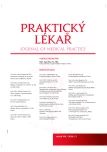The role of the nurse and secondary prevention of stroke
Authors:
L. Šedová 1; F. Dolák 1; S. Bártlová 1; A. Hudáčková 1; L. Rolantová 1; S. Ostrý 1,2
Authors‘ workplace:
Jihočeská univerzita v Českých Budějovicích, Zdravotně sociální fakulta, Ústav ošetřovatelství, porodní asistence a neodkladné péče, Ředitelka: prof. PhDr. Valérie Tóthová, Ph. D.
1; Nemocnice České Budějovice, a. s., Neurologické oddělení, Primář: MUDr. Svatopluk Ostrý, Ph. D.
2
Published in:
Prakt. Lék. 2020; 100(3): 131-133
Category:
Of different specialties
Overview
The article shows the importance of secondary prevention in comprehensive care of a patient after a stroke. Stroke is the second leading cause of hospitalization after heart diseases. Although the incidence of stroke has decreased over the past 20 years, the Czech Republic is one of the countries with a higher incidence of this disease. The treatment of stroke has been constantly improving, much of the professional attention is devoted to continuity of care from pre-medical to medical care in specialized facilities. Home and community care remain a challenge for the Czech Republic’s comprehensive treatment of this disease. Changing the unwanted health stereotypes of lifestyles is crucial for the secondary prevention and is therefore of great importance for the resulting health status of a patient after stroke. The educational role of nurses, which empathic communication and feedback constantly motivate the patients to change their lifestyle is irreplaceable.
Keywords:
risk factor – stroke – Education – secondary prevention – nurse
Sources
1. Norrving B, Barrick J, Davalos A, et al. Action plan for stroke in Europe 2018–2030. Eur Stroke J 2018; 3(4): 309–336.
2. Škoda O, Herzig R, Mikulík R, a kol. Klinický standard pro diagnostiku a léčbu pacientů s ischemickou cévní příhodou a s tranzitorní ischemickou atakou – verze 2016. Cesk Slov Neurol N 2016; 79/112(3): 351–363.
3. Lippertová-Grünerová M. Rehabilitace po náhlé cévní mozkové příhodě. Praha: Galén 2015.
4. Kovářová I, Oktábcová A, Gueye T, Švestková O. Cévní mozková příhoda: Soubor doporučení pro pacienty a jejich rodiny. Rehabil. fyz. Lék. 2018; 25(3): 126–130.
5. Heuschmann PU, Kircher J, Nowe T, et al. Control of main risk factors after ischaemic stroke across Europe: data from the stroke-specific module of the EUROASPIRE III survey. Eur J Prev Cardiol 2015; 22 : 1354–1362.
6. Bruthans J, Mayer O Jr., Šimon J, a kol. Úroveň sekundární prevence cévních mozkových příhod u českých pacientů ve studii EUROASPIRE III – Stroke Specific Module. Cor Vasa 2008; 50(12): 446–454.
7. Vrablík M. Adherence a možnosti jejího ovlivnění. Med. praxi. 2013; 10(11–12): 369–371.
8. Juřeníková P. Zásady edukace v ošetřovatelské praxi. Praha: Grada Publishing 2010.
9. Cífková R, Wohlfahrt P, Krajčoviechová A, et al. Blood pressure control and risk profile in post-stroke survivors. A comparison with the general population. J Hypertens 2015; 33(10): 2107–2114.
10. Feigin V. Cévní mozková příhoda. Prevence a léčba mozkového iktu. Praha: Galén 2007.
11. Heuschmann PU, Kircher J, Nowe T, et al. Control of main risk factors after ischaemic stroke across Europe: data from the stroke-specific module of the EUROASPIRE III survey. Eur J Prev Cardiol 2015; 22(10): 1354–1362.
12. Kalina Z. Akutní cévní mozkové příhody. Praha: Maxdorf 2006.
13. Maasland, L, Koudstaal PJ, Habbema JD, Dippel DW. Knowledge and understanding of disease process, risk factors and treatment modalities in patients with a recent TIA or minor ischemic stroke. Cerebrovasc Dis 2007; 23(5–6): 435–440.
14. O’Donnell MJ, Xavier D, Liu L, et al. Risk factors for ischaemic and intracerebral haemorrhagic stroke in 22 countries (the INTERSTROKE study): a case-control study. Lancet 2010; 376(9735): 112–123.
15. Wohlfahrt P, Cífková R. Proč je v léčbě arteriální hypertenze důležité rychle dosáhnout cílových hodnot krevního tlaku. Vnitř. Lék. 2019; 65(11): 698–697.
16. Vrablík M. Léčba hypertenze a cévní mozková příhoda. Interní Med 2010; 12(5): 280–287.
Labels
General practitioner for children and adolescents General practitioner for adultsArticle was published in
General Practitioner

2020 Issue 3
- Metamizole vs. Tramadol in Postoperative Analgesia
- Advances in the Treatment of Myasthenia Gravis on the Horizon
- Hope Awakens with Early Diagnosis of Parkinson's Disease Based on Skin Odor
- Metamizole at a Glance and in Practice – Effective Non-Opioid Analgesic for All Ages
- What Effect Can Be Expected from Limosilactobacillus reuteri in Mucositis and Peri-Implantitis?
Most read in this issue
- Diagnosis and treatment of Latent Autoimmune Diabetes in Adults in everyday clinical practice
- Methods of non-pharmacological treatment in rheumatoid arthritis
- Current possibilities of diagnostics and treatment of cartilaginous lesions of weight-bearing joints
- The role of the nurse and secondary prevention of stroke
